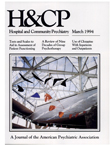Patient Response to Clozapine in a Forensic Psychiatric Hospital
Abstract
If a decrease in total BPRS score of 15 percent or more is taken as the criterion for clinical effctivcness of clozapine, 70 percent of the patients in the study group had a clinically effective response within six months after starting the medication. The study group showed improvement in both positive and negative psychotic symptoms, and most achieved higher levels of patient privileges after treatment with clozapine.
Although positive and negative symptoms of psychosis were not completely alleviated, the frequency and intensity of such symptoms decreased dramatically. Improvement was noted in social interactions, grooming, daily living skills, autonomous functioning, and diminished aggressiveness. As a result of these improvements, 70.3 percent of the patients on clozapine achieved a level of patient privileges that had been achieved by only 3.7 percent of patients before treatment.
In addition to clozapinc's direct effect on dopaminc receptors, the reduction in the symptoms of movement disorders associated with discontinuation of typical antipsychotics may have contributed to patient improvement. Akathisia can be a source of anxicty and depression, and akinesia may be manifested as a be havioral state of diminished spontaneity characterized by few gestures, lack of spontaneous speech, and, particularly, apathy and diffidulty initiating usual activities. The virtual absence of akinesia and a marked decrease in akathisia among the study patients may have contributed to improvement in BPRS ratings of anxiety, depression, and negative symptoms.
The patients we studied were more prone to the adverse effects of clozapine than were the patients studied in clozapine clinical trials. Some of this variation may be adcounted for by the small sample size of our study group. We speculate that the high incidence of constipation among the study patients may be related to their long history of high-dose antipsychotic treatment, which may have contributed to depatients with a prolonged history of inpatient psychiatric hospitalization may be less likely to be active and thus more likely to develop side effects such as constipation.
Study subjects who developed hypertension appeared more likely to develop this side effect later in treatment with clozapine and at higher doses. However, the small size of the study group makes it difficult to assess the relationship between the dose of clozapine and development of hypertension.
Access content
To read the fulltext, please use one of the options below to sign in or purchase access.- Personal login
- Institutional Login
- Sign in via OpenAthens
- Register for access
-
Please login/register if you wish to pair your device and check access availability.
Not a subscriber?
PsychiatryOnline subscription options offer access to the DSM-5 library, books, journals, CME, and patient resources. This all-in-one virtual library provides psychiatrists and mental health professionals with key resources for diagnosis, treatment, research, and professional development.
Need more help? PsychiatryOnline Customer Service may be reached by emailing [email protected] or by calling 800-368-5777 (in the U.S.) or 703-907-7322 (outside the U.S.).



